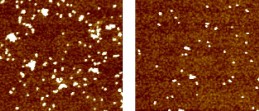NIST ‘catch and release’ program could improve nanoparticle safety assessment
June 9, 2011

After gold nanoparticles are trapped on the brown collection surface (left), the NIST team can apply a mild electric field and release most of them (right) (credit: NIST)
Scientists at the National Institute of Standards and Technology (NIST) have found a way to manipulate nanoparticles to assess nanoparticle toxicity.
They scientists developed a method of attracting and capturing metal-based nanoparticles on a surface and releasing them at the desired moment.
The method uses a mild electric current to influence the particles’ behavior, which could allow scientists to expose cell cultures to nanoparticles so that any lurking hazards they might cause to living cells can be assessed effectively.
The team used a gold surface covered by long, positively charged molecules, which stretch up from the gold. The nanoparticles, which are also made of gold, were coated with citrate molecules that have a slight negative charge, which draws them to the surface covering, an attraction that can be broken with a slight electric current.
The scientists said the method also has the advantage of collecting the particles in a layer only one particle thick, which allows them to be evenly dispersed into a fluid sample, thereby reducing clumping — a common problem that can mask the properties they exhibit when they encounter living tissue.
Ref.: Darwin R. Reyes, et al., Trapping and Release of Citrate-Capped Gold Nanoparticles, Applied Surface Science, 2011; [DOI: 10.1016/j.apsusc.2011.04.030]